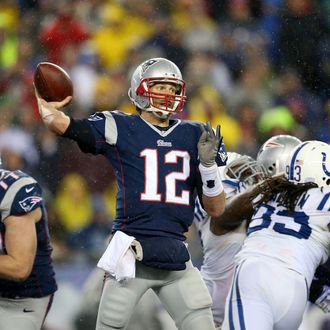
The Wells Report released yesterday found it was “more probable than not” that Tom Brady was “at least generally aware” that low-level Patriots employees deflated footballs in advance of last season’s AFC Championship Game. But Brady’s agent Don Yee has fired back, claiming, among other things, that the law firm that prepared the report had a conflict of interest and that the investigators had a limited understanding of football. But one accusation stands out: that the NFL cooperated with the Patriots’ opponent, the Indianapolis Colts, in what Yee calls “a sting operation.” The findings of the report, though, don’t really back up those claims.
First, here’s an excerpt of Yee’s statement, via Deadspin:
“The Wells report, with all due respect, is a significant and terrible disappointment. Its omission of key facts and lines of inquiry suggest the investigators reached a conclusion first, and then determined so-called facts later. One item alone taints this entire report. What does it say about the league office’s protocols and ethics when it allows one team to tip it off to an issue prior to a championship game, and no league officials or game officials notified the Patriots of the same issue prior to the game? This suggests it may be more probable than not that the league cooperated with the Colts in perpetrating a sting operation.”
On its face, it raises a reasonable question: If the Colts had alerted the league that they believed the Patriots deflated balls, how were they allowed to use such balls in a game? The answer is pretty clearly spelled out in the report. There are at least five good reasons to think that there was no conspiracy against the Patriots:
1. The “Tip” the NFL Recieved Contained No Evidence
On the day before the AFC title game, Colts GM Ryan Grigson sent an email to the league, which contained a message from Sean Sullivan, the team’s equipment manager. The email said it was “well known around the league” that the Patriots’ ballboys are known to let air out of game balls after they’ve been inspected. The report states that the email was eventually forwarded to game operations personnel who would be on site at the game. Yee criticized the report for hiding information in footnotes, and in this section, a footnote is indeed relevant: “Because Sullivan’s email did not provide specific factual support for the Colts’ concerns, NFL officials determined that it was not necessary to ask the game officials preemptively to check the air pressure in the Patriots game balls during the game, as Sullivan had requested.” That makes sense: It’s reasonable for the league to not deviate from its protocol of only checking balls pregame based on an email that didn’t cite specific evidence.
2. There Was No Reason for the NFL to Tell the Pats About the Tip
As for why the league didn’t inform the Patriots of the Colts’ concerns, well, why would they tell them about an accusation that wasn’t factually supported, and that they didn’t intend to act on? Some have wondered whether the league was just lazy (or perhaps didn’t want to know what was going on), but what Yee is suggesting is much more sinister.
3. The Pregame Inspection Didn’t Reveal Anything Suspicious
The game’s referee did check the balls in advance of the game, and at the time, the air pressure was found to be legal. From the report: “When interviewed, [referee Walt] Anderson said that the issue had been raised with him, but that he had not been overly concerned because he knew that he would check the footballs himself prior to the game, as was his usual practice, and expected that the footballs would remain secure until game time. Anderson does not appear to have highlighted the concerns raised about the game balls during the crew meeting, although he believes that the issue may have been mentioned casually.” The biggest mistake, in that case, is that league officials let the balls out of their sight between inspection and kickoff — when the report claims the balls were deflated. But that hardly suggests a sting. It only shows the Patriots were pretty good, initially, at outsmarting the game officials.
4. There’s No Evidence the Referee Was Setting the Pats Up
The report details the hectic moments leading up to kickoff. Anderson couldn’t find the approved game balls (which we now know had been improperly removed from the officials’ room), and so the game could begin, a security representative was sent to retrieve the backup balls that had been prepared by each team. But the balls turned up just before kickoff. Yee didn’t specify who exactly was in on the alleged sting, but for Anderson to be involved, it would mean he knew (or at least believed) that the Patriots had tampered with the balls after he’d approved them, and that he allowed them to be used so the league could catch them in the act later. There’s no evidence to suggest that’s the case.
5. The League Only Broke Protocol When It Had Hard Evidence
It was only after Indianapolis linebacker D’Qwell Jackson intercepted a pass in the first half that the Colts could lodge a specific complaint. The ball he caught was tested by Colts’ personnel on the sideline and found to be under-inflated, and league officials were alerted. With hard (soft?) evidence that something might be wrong, the officials ordered balls checked at halftime, and found that each of the Patriots’$2 11 game balls were under-inflated. At that point, the Patriots were caught in the act — but they only have themselves to blame.





























